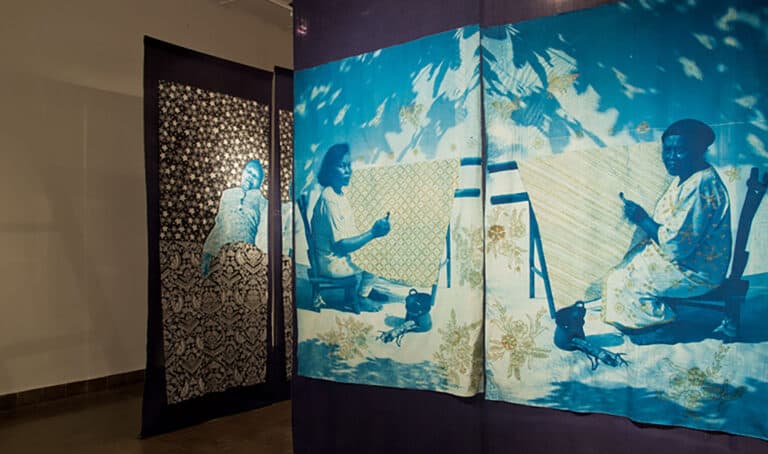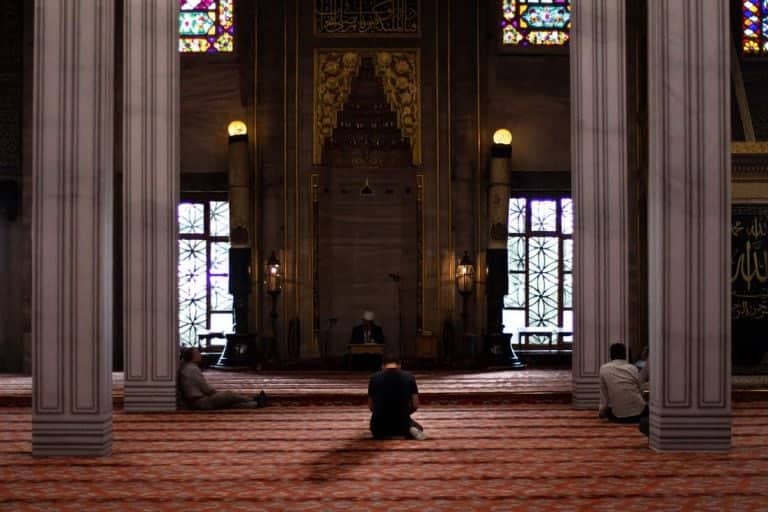If you’ve been following us for a bit, you might realise that this past year has been a flurry of travel all around the region. This has been due in no small part to the emergence of a number of different art biennales (or biennials, depending on your leaning, or dare we say colonial master), in various Southeast Asian capitals. As of end 2017, we counted Jakarta (November – early December 2017), Kuala Lumpur (KL)(November 2017 to March 2018) and Manila (February to March 2018). Thailand is perhaps a little late to the party but is expected to make a strong showing with no less than three presentations this year, with the Bangkok Art Biennale, the Thailand Biennale and the Bangkok Biennial.
Before we launch into our survey of what’s been happening regionally, let’s take a step back and remind ourselves of what biennales are and the function that they play in the wider art ecosystem. The most famous biennale of all, is perhaps the Venice Biennale, a showcase of art which first took place in 1895. Another important thing to note is the primacy that’s given to geography, whenever one thinks about biennales. They are the Venice Biennale, the Jakarta Biennale, the Manila Biennale, with such names reminding the viewing public that these art shows are deeply tied to their physical locations.
What does all this really mean?
For the business-minded, the opportunities for commerce and trade immediately leap into mind. Think of the tourist dollars that flow in whenever high-rolling, mobile art collectors and enthusiasts sweep into town. The gloss of an art biennale immediately elevates the cultural capital of a city. As academic and curator Paul O’Neill quite rightly observes, “biennales and art fairs are happening more and more in cities that have adopted cultural tourism as a means of securing a place in the international arena of economy and culture.”
On a more esoteric level, however, consider what it means when a group of artworks are displayed together and slapped with a geographic label. Does it, for example, mean that all the works displayed at the Venice Biennale are representative of Venice and the people who live in the city? Can diversity ever be accurately reflected in a small grouping of curator-selected works? Is that even the aim, when the economics of the art biennale are considered – if a city is to be showcased at its picture-perfect best for the outside world, is there any place for its grimy underbelly? Is there any way to authentically represent the periphery of a society in an art biennale, without being twee or exploitative? Who should the curators even be? What kinds of foreign artists should be invited?
Let’s take a look at how the concept of the biennale has taken hold in Southeast Asia in recent times.
Jakarta
We begin with Jakarta (our video walkthrough is here if you have little patience for the written word). The 2017 Jakarta Biennale was mainly held in Gudang Sarinah, South Jakarta, an unflinchingly grey converted aeroplane hangar. It was themed around the concept of Jiwa (soul) to “discuss wide-ranging issues and inquiries into contemporary arts and culture.” Jiwa was meant to be construed as “a basic human impulse, togetherness, society, nature, or anything intangible and spiritual.”
Artistic Director Melati Suryodarmono commented that, through the exhibition, visitors would be able to “observe various relations, provoke sensibility, feelings and enrich (their) intellectual horizons.”
On our visit, we felt a general air of reckless abandon which suited the post-apocalyptic venue well. When the skies opened up during our tour, we had little choice but to sprint between buildings using spare jackets and scarves as makeshift umbrellas, while narrowly avoiding falling into Siti Adiati’s Enceng Gondok Blossoming Gold flower pond:
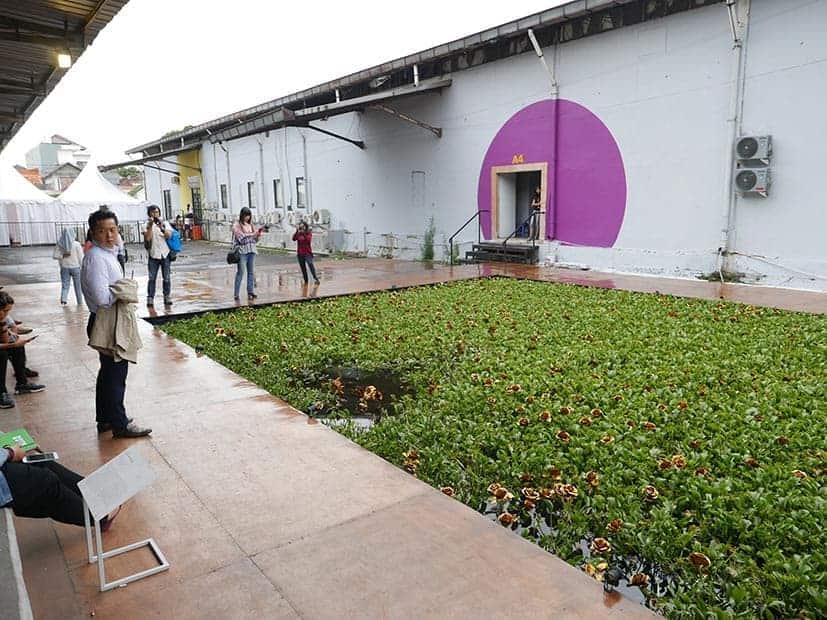

The national art biennale has its roots in the idea of creating a sense of spectacle for visitors – both local and foreign. It’s a way to show off the cultural and artistic capabilities of a place, and quite often, the showier it is, the better.
It was fitting therefore that the Jakarta Biennale featured the theme of spirituality – for what the show lacked in physical infrastructure, was made up for in spades by its gritty salt-of-the-earth appeal:

The first work we stumbled upon was Singapore artist Robert Zhao’s The World Will Surely Collapse, Trying to Remember A Tree III, a hugely popular 17m – long series of lightboxes depicting a fallen tree that saw many local visitors snapping selfies and photos. The grainy images and monochromatic tones set the exhibition space off beautifully. They were luminescent and cast an eerily cool glow:

Another show stopper was Made Djirna’s Unsung Heroes, a massive installation of found objects from the Bali coastline, strung up and piled around a corner like a giant rock cave – the insides of the installation were suffocatingly warm, but that didn’t stop visitors from posing for their requisite photographs:
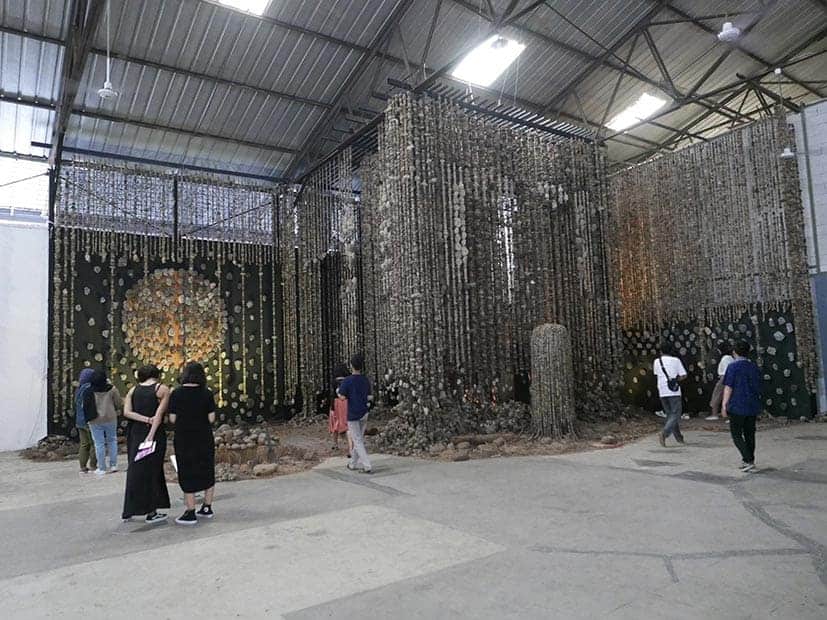
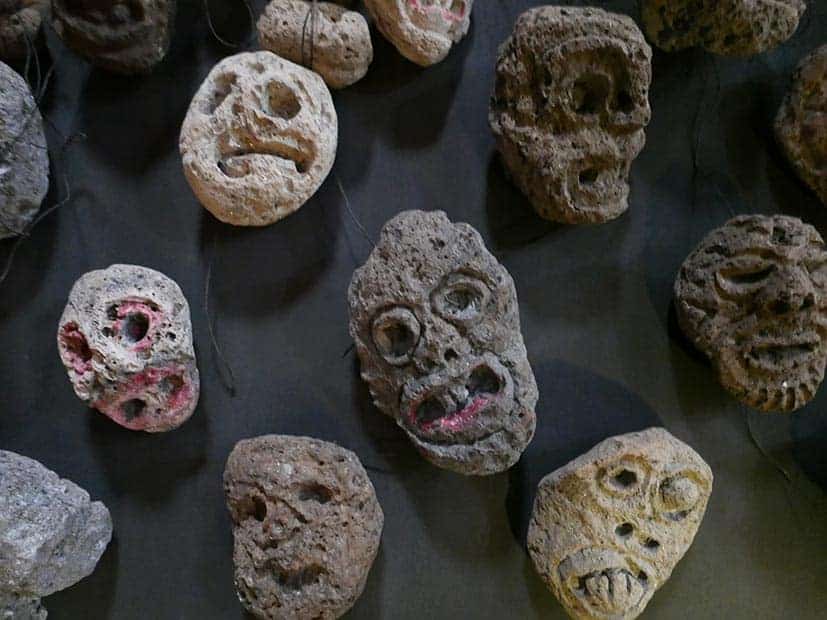
The Semsar Siahaan tribute at the Jakarta Biennale deserves a mention as well. It seems that the late activist artist is experiencing something of a Renaissance, given the recently- concluded retrospective Art, Liberation at Gajah Gallery in Singapore. If the showing at Gajah was a Michelin – starred gourmet presentation of Semsar’s large and important works, the tribute at the Jakarta Biennale was the comforting home-cooked dish that one might choose as a favourite last meal:


Sketches and pages from the artist’s personal diaries featured prominently at the event, offering a glimpse into the mind of an artist that – according to art historian T.K. Sabapathy – “was at one point in the 1980s, the most prominent artist” in the Indonesian contemporary art scene:
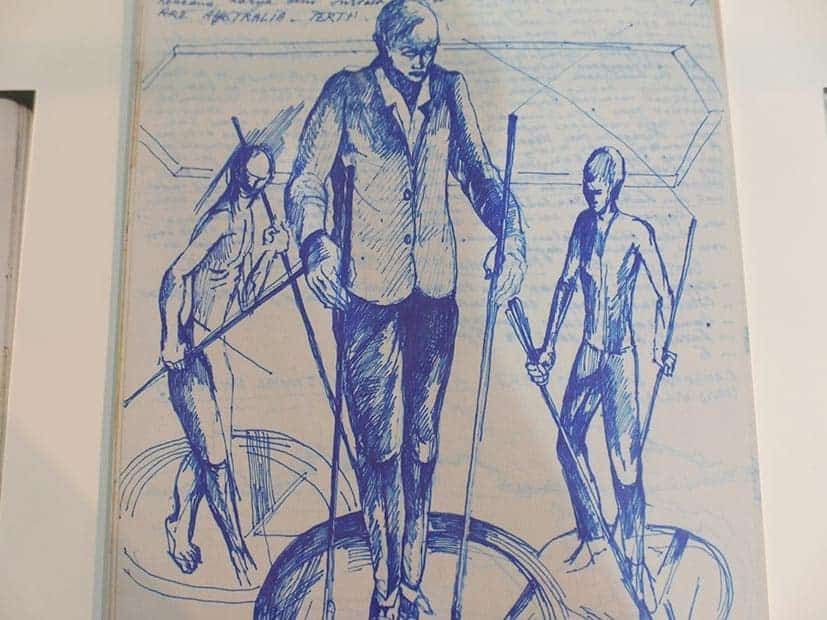

The Jakarta Biennale attracted around 30,000 visitors, mostly young people, a fact which was abundantly clear during our visit. Kids posed with works, several of them fondling the actual pieces.
One wonders – did the works simply offer more of an opportunity for interaction?
For example, check out Indonesian artist Hanafi’s parkas studded with sharpened pencils. We literally waited in line for a chance to take photos against a backlit wall studded with yet more pencils, finally giving up and bowing down to the superior stamina of the millennials ahead of us. Works such as these simply screamed out for participation and interaction:
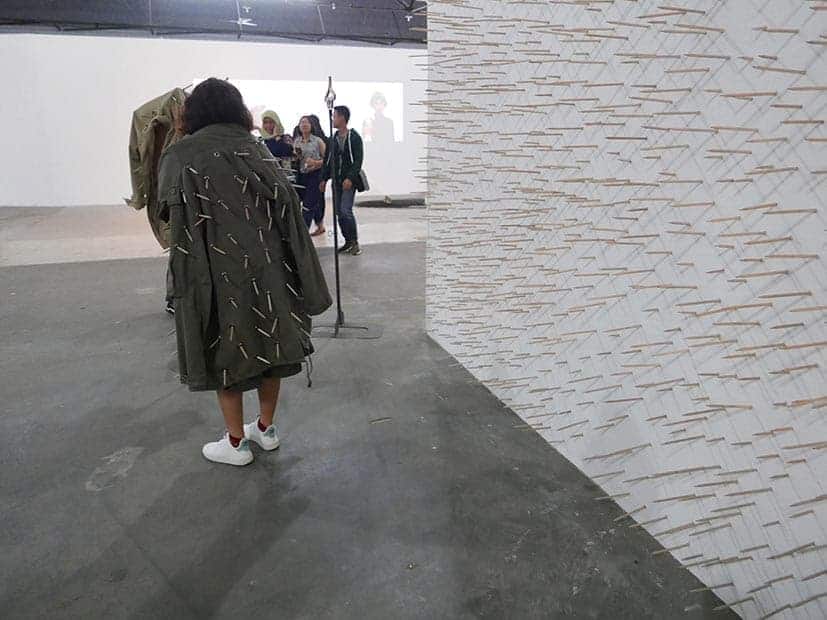
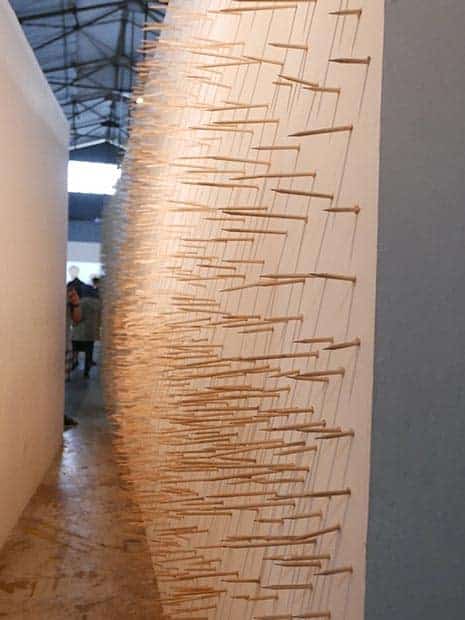 We found that the stark greyness of the hangar space was an excellent complement to the sobering themes addressed in the art. Indeed, the Jakarta Biennale was bold in its commentary that “amid the current system that is rife with fanaticism, the loss of politicians’ sanity, intolerance, and struggle for space, it is pertinent and crucial to rethink the forces underlying human desires, observe plural relationships, and make use of our senses, sensibilities, and knowledge.”
We found that the stark greyness of the hangar space was an excellent complement to the sobering themes addressed in the art. Indeed, the Jakarta Biennale was bold in its commentary that “amid the current system that is rife with fanaticism, the loss of politicians’ sanity, intolerance, and struggle for space, it is pertinent and crucial to rethink the forces underlying human desires, observe plural relationships, and make use of our senses, sensibilities, and knowledge.”
It was unclear whether the “current system” referred to, was that of the Indonesian political situation, or that of the wider world. Perhaps the Jakarta Biennale owes some of its curatorial confidence to its longstanding historical roots – its first incarnation took place in 1968 as the Pameran Besar Seni Lukis Indonesia (Grand Exhibition of Indonesian Painting) at the Jakarta Arts Center. It’s also weathered its fair share of controversy when it was shut down in 2005 after Islamic fundamentalists disapproved of Agus Suwage’s “pornographic” installation Pinkswing Park, which displayed near-naked male and female bodies.
KL and Manila, by contrast, hosted their inaugural art biennales in 2017.
Kuala Lumpur
The KL showing was mainly displayed in the National Visual Arts Gallery, adopting the rather broad concept of Alami Belas (to “be loved”). It sought to depart from “usual themes of international biennales such as divergence, ethnic conflict, war and politics.”
Did this make for a more vanilla showing of art?
More quotidian issues were certainly addressed, such as an installation by Ahmad Sanuri Zulkefli, The Story Of Merah, which focused on the theme of “love for animals.” This particular work documented a sad story about an attack on a cat, bludgeoned with a helmet by an enraged motorcyclist:
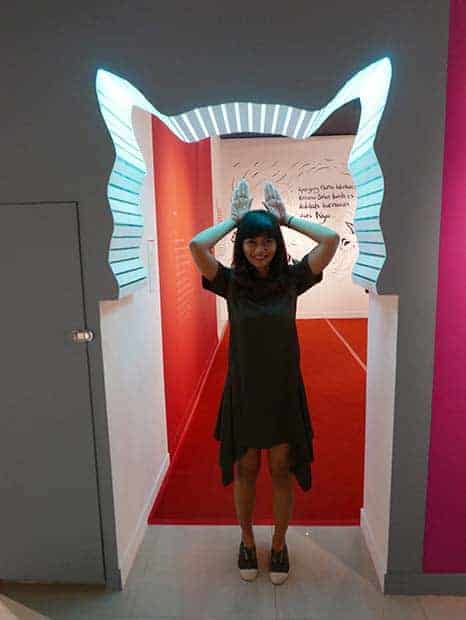
But, if you knew where to look for them, there were works on display which were more than capable of delivering the proverbial sucker punch. Case in point, Chang Yoong Chia’s wonderful Otaru Fable (2017), a series of 63 painted and marked scallop shells from Japan, given a second life in this installation to create a beautifully poetic manga sequence of 31 images and 31 texts, on the futilities and ironies of modern life:
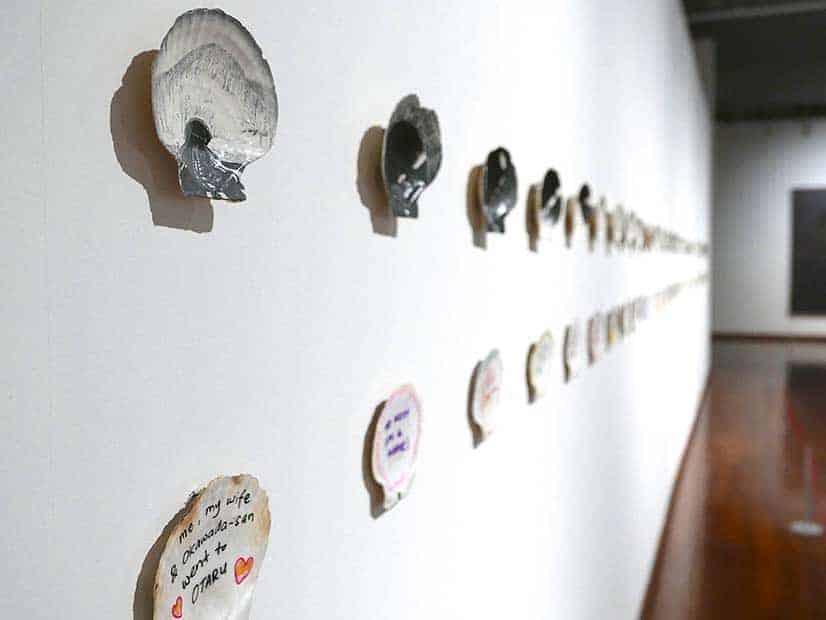
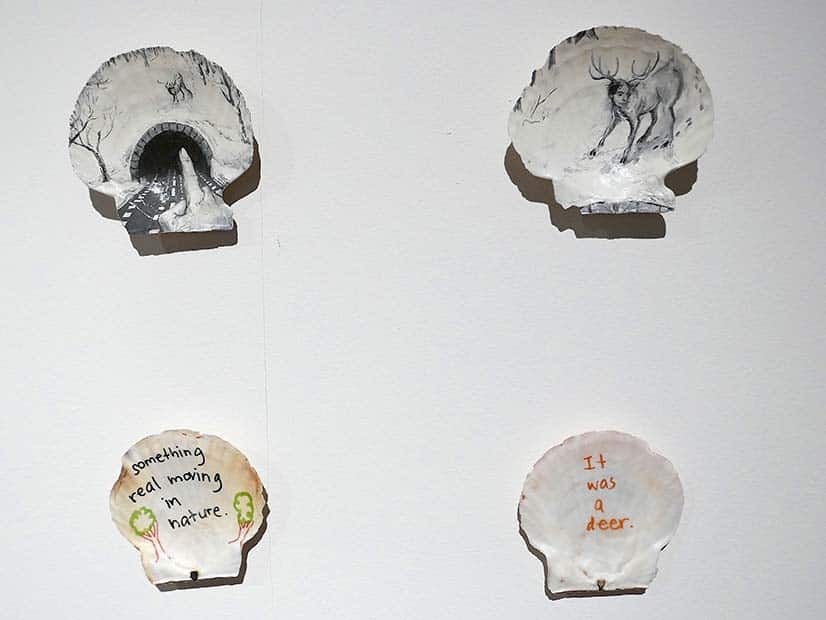
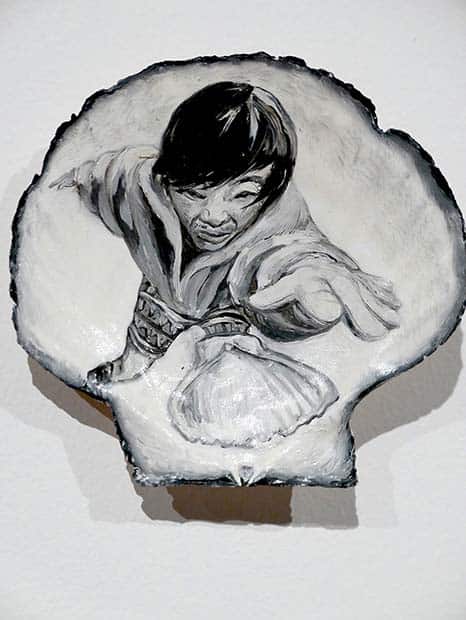 The documentation of Anida Yoeu Ali’s glittering performance in the United States, 99 Red Chadors was brave and impactful, in a way because of its relatively bland accompanying wall text which referred vaguely to the artist’s “bridging of the interior and exterior space of the self.”
The documentation of Anida Yoeu Ali’s glittering performance in the United States, 99 Red Chadors was brave and impactful, in a way because of its relatively bland accompanying wall text which referred vaguely to the artist’s “bridging of the interior and exterior space of the self.”
It made us think about the role of women in Islamic-dominated societies and of the very many parts of their lives which continue to remain unseen and unheard. The display conjured up images of the Cold War-era song 99 Red Balloons which tells the story of 99 balloons floating into the air, triggering an apocalyptic overreaction by military forces. Similarly, Ali’s artwork prompts viewers to think about their own reactions to an in-your-face expression of female religious identity:
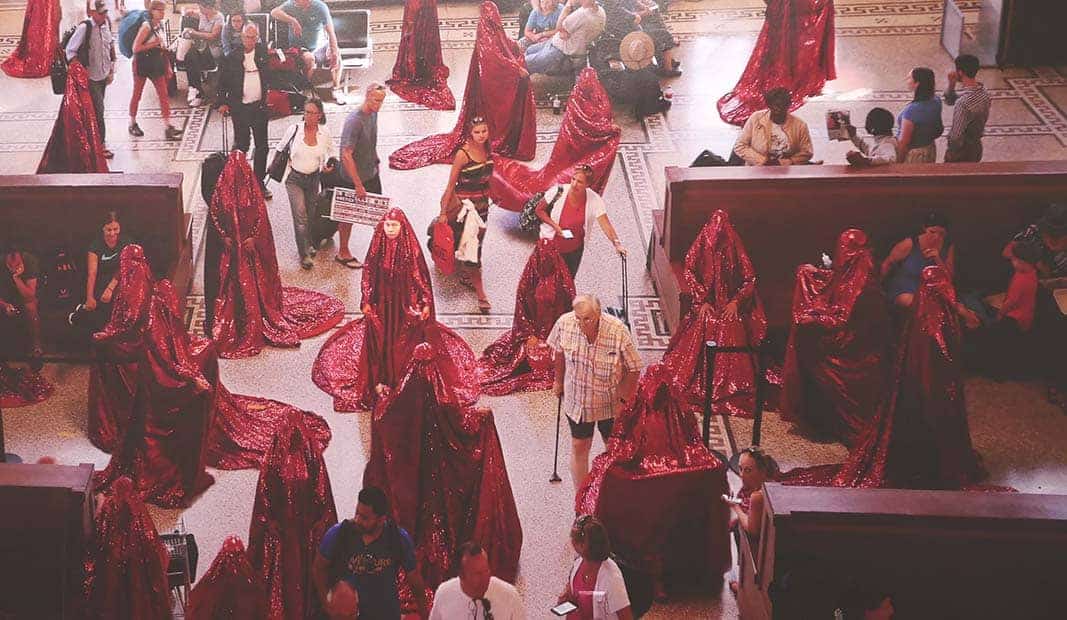
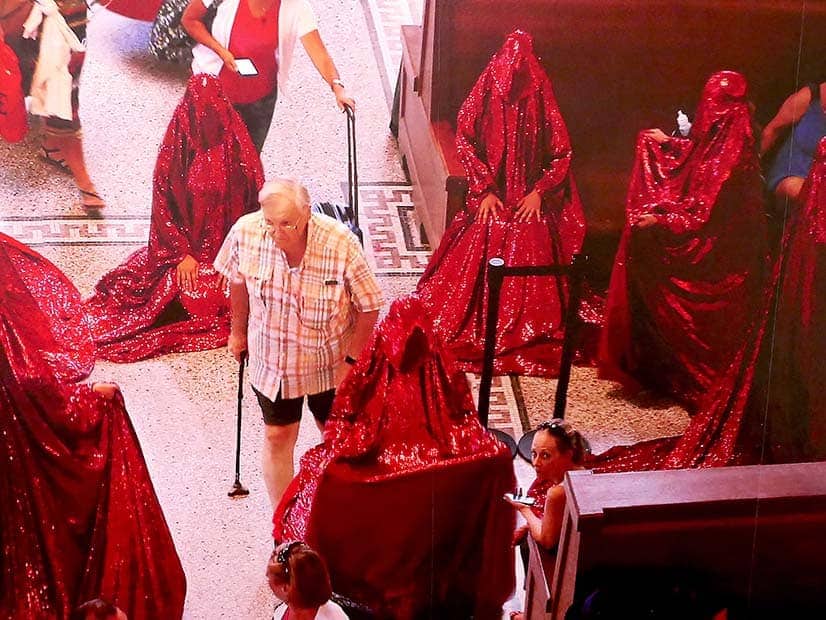
Manila
The Manila Biennale rounds off this particular survey. While observers such as Elena Filipovic have criticised biennales for showing artworks in “specially constructed settings that replicate the rigid geometrics of the modernist white cube…thereby ignoring the multiplicity of creative voices on display,” the Manila Biennale deserves special mention for its breathtaking use of the entire city of Intramuros as its exhibition space. Its theme Open City cleverly referenced globalisation as well as the military status of being “open” for invading forces.
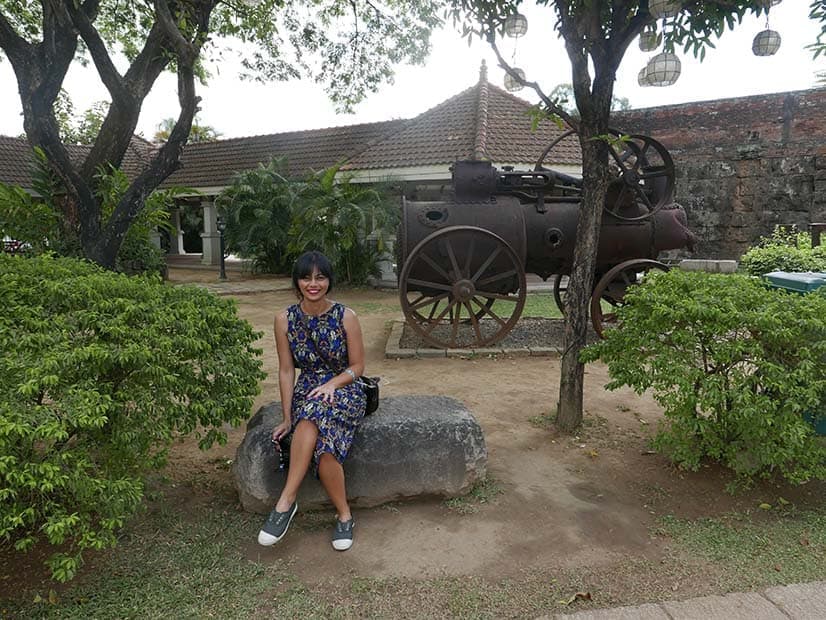
The dark history of Intramuros as the site of fierce warfare in World War II informed and inspired many works on display, and the effect produced was utterly gut-wrenching. Towards the end of the war in 1945, Japanese soldiers barricaded themselves in Intramuros along with civilians and the city was devastated by American shelling. One moved, rather whimsically from site to site on a horse carriage, or kalesa (although I was later informed by a guide that the use of the horses as a tourist gimmick has been regarded as unethical).
Hikaru Fuji’s mixed media installation Record of the Bombing (2016) was made in response to aborted plans in the 1990s to create a memorial hall to communicate the experience of war to future generations and in so doing highlight Japan’s own acts of aggression. The installation challenged such historical denials, featuring a collection of empty display cases (which were labelled nonetheless with phrases such as “iron helmet charred in an air raid” and “death certificate”). It was a powerful exhibition of “war artefacts,” which were simply not there, in the same way that Japanese acknowledgement of its wartime atrocities has been absent from contemporary Japanese narratives:
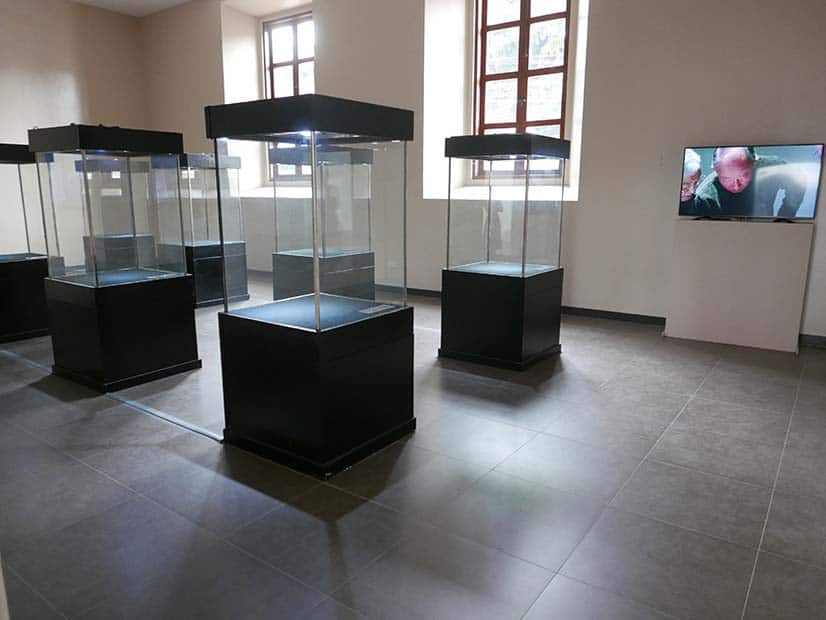
Toym De Leon Imao’s 2018 work ASKal”: Auto- Synchronus Kalsa was a glorious woven ode to jeepneys, reconfigured American World War II jeeps which are found in Manila streets and which typically house a variety of elements such as Japanese engines and Catholic altars. The word askal is a colloquial term for stray dogs and is playfully put to use in the work’s title to communicate the hybridity in Filipino culture:
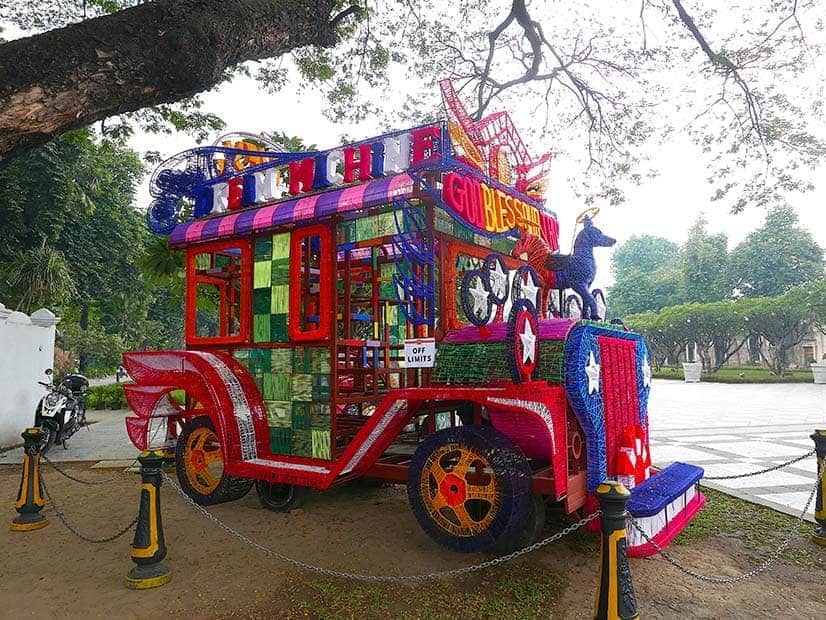
Lady Liberty by Kawayan de Guia installed in Fort Santiago, was a massive ramshackle two-headed statue addressing the fall of the Americans during the war and the subsequent destruction of Manila. Viewers were allowed to vandalise the statue as a statement on the city being “constantly vulnerable to further attack and degradation:”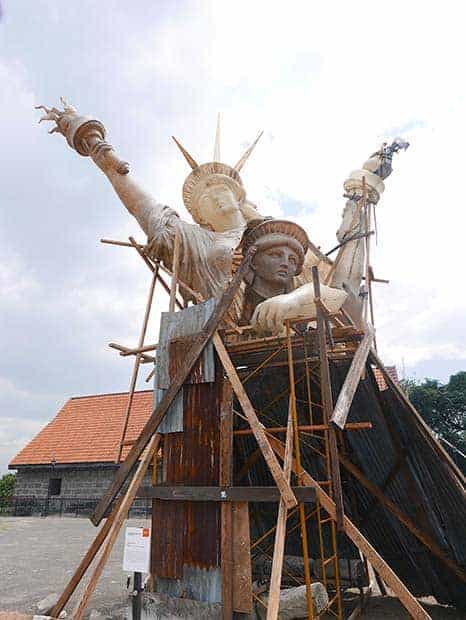
To the point about whether the spectacle of the biennale can ever be reconciled with the authentic representation of a city, we would offer the viewpoint that authenticity is intrinsically fundamental to the success of the spectacle, however such idea of “success” might be framed. One can easily forget the shiny façade of a city, but not so quickly the soul and spirit of its people.
Just like any art exhibition, biennales which merely showcase success, sophistication and glamour are bound to make for a rather sterile showing. Perhaps the artworks in a biennale do not need to speak for every community within a city, but rather should be able to speak to as many different communities as possible, in conveying the nuances of its locus in a tight and focused way. As O’Neill observes, biennales “create a type of viewer, who as a global tourist, is always on the move..like all tourists, he or she may experience other cultures as a means of defining his or her own.”
In the Southeast Asian context, we found that when our regional audience was able to interact with the works in an unselfconscious way, such interaction brought forth a measure of connectedness which is sometimes absent in more serious and traditional settings. In the biennales we visited, exhibited works seemed to create more of an impact when things were just more fun.
It is, of course, possible to dismiss such active interaction as being the hallmark of an unsophisticated art audience but the fact remains that audience engagement (however one might achieve it), is often the lynchpin of authenticity and effectiveness in art.
Interestingly, curator Tan Boon Hui has identified a Southeast Asian penchant for storytelling, arguing that the persistence and desire for art to communicate a narrative, has been a key factor behind the flourishing of realist and figurative painting in Southeast Asian art. Perhaps it is this same desire for authorship which motivates Southeast Asian viewers to interact so aggressively with their art? After all, aren’t we all the heroes of our own stories?
Or maybe it’s all just for fun in the age of Facebook and the ‘Gram.
Either way, it’s clear that this is just the beginning for Southeast Asian biennales and we can’t wait to see what comes next.






